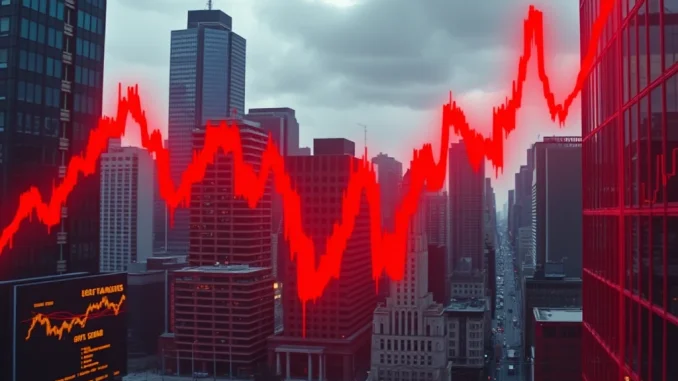
Hold onto your hats, crypto enthusiasts! While we often keep a keen eye on Bitcoin and Ethereum, today’s news from the traditional financial world is sending shockwaves that could ripple through the crypto markets. The major U.S. stock market indices just took a significant nosedive, and it’s crucial to understand what this stock market crash means, not just for Wall Street, but potentially for your digital assets too.
What Triggered This Shocking Market Downturn?
Let’s cut to the chase. Today wasn’t a good day for the bulls in the U.S. stock market. All three major indices – the S&P 500, Nasdaq, and Dow Jones – closed sharply lower. The numbers are pretty stark:
- S&P 500: Down a staggering 5.98%
- Nasdaq: Fell by 5.82%
- Dow Jones: Decreased by 5.50%
These aren’t just minor dips; these are substantial declines, painting a clear picture of a broad market downturn. But what exactly caused this sudden plunge? While pinpointing one single cause is often an oversimplification, several factors are likely at play:
- Economic Data Concerns: Recent economic data might be painting a less rosy picture than anticipated. Perhaps inflation is proving stickier than hoped, or growth forecasts are being revised downwards. Negative economic signals can spook investors and trigger sell-offs.
- Geopolitical Uncertainty: Global events always have the potential to rattle markets. Increased geopolitical tensions or unexpected international incidents can lead to investor nervousness and a flight to safety.
- Profit Taking and Market Correction: After a period of gains, markets are sometimes due for a correction. Investors might be taking profits, leading to a downward pressure. It’s a natural part of market cycles, although the speed and severity of today’s drop are noteworthy.
- Sector-Specific Weakness: Certain sectors within the stock market might be facing particular headwinds. For example, concerns about tech valuations could be weighing heavily on the Nasdaq.
Decoding the Impact: S&P 500, Nasdaq, and Dow Jones in the Red
Let’s break down each index and understand what these declines signify.
S&P 500: A Broad Market Barometer
The S&P 500 is often considered the most representative index of the overall U.S. stock market. It tracks the stocks of 500 large-cap U.S. companies, covering a wide range of sectors. A significant drop in the S&P 500, like the near 6% decline we witnessed today, indicates widespread selling pressure across the market. This suggests that the negative sentiment isn’t isolated to a few sectors but is rather a broader market concern.
Nasdaq: Tech Stocks Take a Hit
The Nasdaq Composite is heavily weighted towards technology stocks. It’s a key indicator of the health of the tech sector and growth stocks in general. A sharp fall in the Nasdaq, similar to today’s 5.82% drop, often points to concerns about the future growth prospects of tech companies or potential shifts in investor sentiment away from high-growth, potentially riskier assets. For crypto enthusiasts, the Nasdaq’s performance can sometimes be seen as a directional indicator for the appetite for riskier assets, including cryptocurrencies.
Dow Jones: Blue Chips Under Pressure
The Dow Jones Industrial Average, while composed of only 30 large, established companies (often called blue-chip stocks), is still a widely followed index. A 5.50% decline in the Dow Jones signals that even the more established, traditionally stable companies are facing selling pressure. This can indicate broader economic anxieties, as these companies are often seen as bellwethers for the overall economy.
Why Should Crypto Holders Care About a Stock Market Crash?
You might be thinking, “Okay, the stock market is down, but what does this have to do with my Bitcoin or Ethereum?” The truth is, the traditional financial markets and the cryptocurrency markets are becoming increasingly interconnected. Here’s why today’s stock market crash should be on your radar:
- Risk-On, Risk-Off Sentiment: Both stocks and cryptocurrencies are often considered risk-on assets. When investors become risk-averse due to economic uncertainty or market downturns, they tend to pull money out of risk-on assets across the board. This means that a negative day in the stock market can sometimes spill over into the crypto market, leading to downward pressure on crypto prices as well.
- Institutional Investment Overlap: More and more institutional investors are now involved in both the stock market and the cryptocurrency market. Large investment firms managing portfolios across asset classes may react to a stock market downturn by reducing exposure to other risk-on assets, including crypto, to rebalance their portfolios or mitigate overall risk.
- Economic Outlook and Investor Confidence: A significant market downturn in the stock market can be a sign of broader economic concerns. This can impact overall investor confidence and liquidity, potentially affecting investment flows into all asset classes, including cryptocurrencies.
- Correlation (Sometimes): While the correlation isn’t always perfect or consistent, there have been periods where the cryptocurrency market has shown a degree of correlation with the stock market, particularly with the tech-heavy Nasdaq. During times of market stress, this correlation can become more pronounced.
Navigating the Market Downturn: Actionable Insights
So, what should crypto investors do in the face of this market downturn in the traditional stock market?
- Stay Informed: Keep a close eye on both traditional financial news and crypto news. Understand the factors driving market movements in both spaces.
- Assess Your Risk Tolerance: Market volatility is inherent in both stock and crypto markets. Ensure your portfolio allocation aligns with your risk tolerance. Downturns can be stressful, but they can also present buying opportunities for long-term investors.
- Do Your Own Research (DYOR): Don’t make impulsive decisions based on short-term market fluctuations. Continue to research the projects you’re invested in and understand their fundamentals.
- Consider Diversification: Diversification across different asset classes can help mitigate risk. While crypto can be part of a diversified portfolio, it’s important to consider your overall asset allocation strategy.
- Long-Term Perspective: Remember that both the stock market and the cryptocurrency market have historically experienced cycles of booms and busts. Focus on the long-term potential of your investments rather than getting overly caught up in short-term volatility.
The Road Ahead: What’s Next?
Today’s stock market crash is a significant event, and its full implications will unfold in the days and weeks to come. Whether this is a short-term correction or the start of a deeper bear market remains to be seen. For crypto investors, it’s a reminder that the financial world is interconnected and that events in traditional markets can have a ripple effect on the digital asset space.
Stay vigilant, stay informed, and remember that market volatility, while unsettling, is also a part of the investment landscape. By understanding the dynamics at play and maintaining a long-term perspective, you can navigate these turbulent times and position yourself for future opportunities in both the crypto and traditional financial markets.



